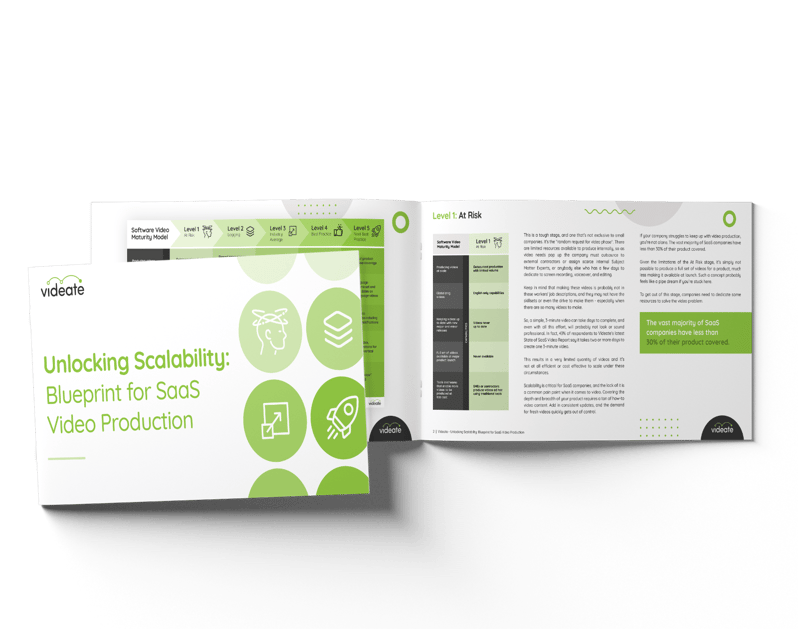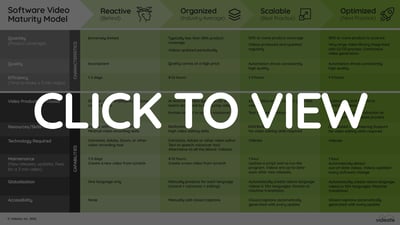The Software Video Maturity Model
SaaS software companies relentlessly focus on enabling customers to quickly realize value. The faster users get value, the more satisfied the customer. The more value that users get, the stickier the solution becomes.
Customer success, support, education and technical documentation teams are all involved in helping customers realize value. Business objectives include:
- Drive customer growth
- Reduce churn
- Improve NPS and customer satisfaction scores
- Support call deflection in order reduce support call volume
- Accelerating onboarding process
Video has emerged as one of the best tools to support these goals.
Developing a comprehensive library of “how-to videos” that are always up to date and available in the native languages that matter is game changing.
Traditionally, SaaS companies have had challenges keeping up with the demand for “how-to” videos. Today’s continuous software deployment approach means new features are constantly being released, and videos are frequently out of date. In recent years, video production has evolved significantly. Generative AI and advances in text to speech are enabling teams to:
- Produce more videos and cover more use cases
- Keep videos up to date in environments with frequent software release
- Product videos in all the languages that matter
To help understand how mature your video production capabilities are, we developed the Video maturity model. This framework helps SaaS businesses think about where they are and where they need to be in terms of software how-to video libraries.
Use this model to get a realistic picture of:
- Your business’s current stage
- What that stage’s average output looks like
- Common challenges of the stage
- What’s needed to improve your video production workflow
Identifying where you are and where you need to be on this model will guide you on a path towards your goal and also map out the tools you need to get there.
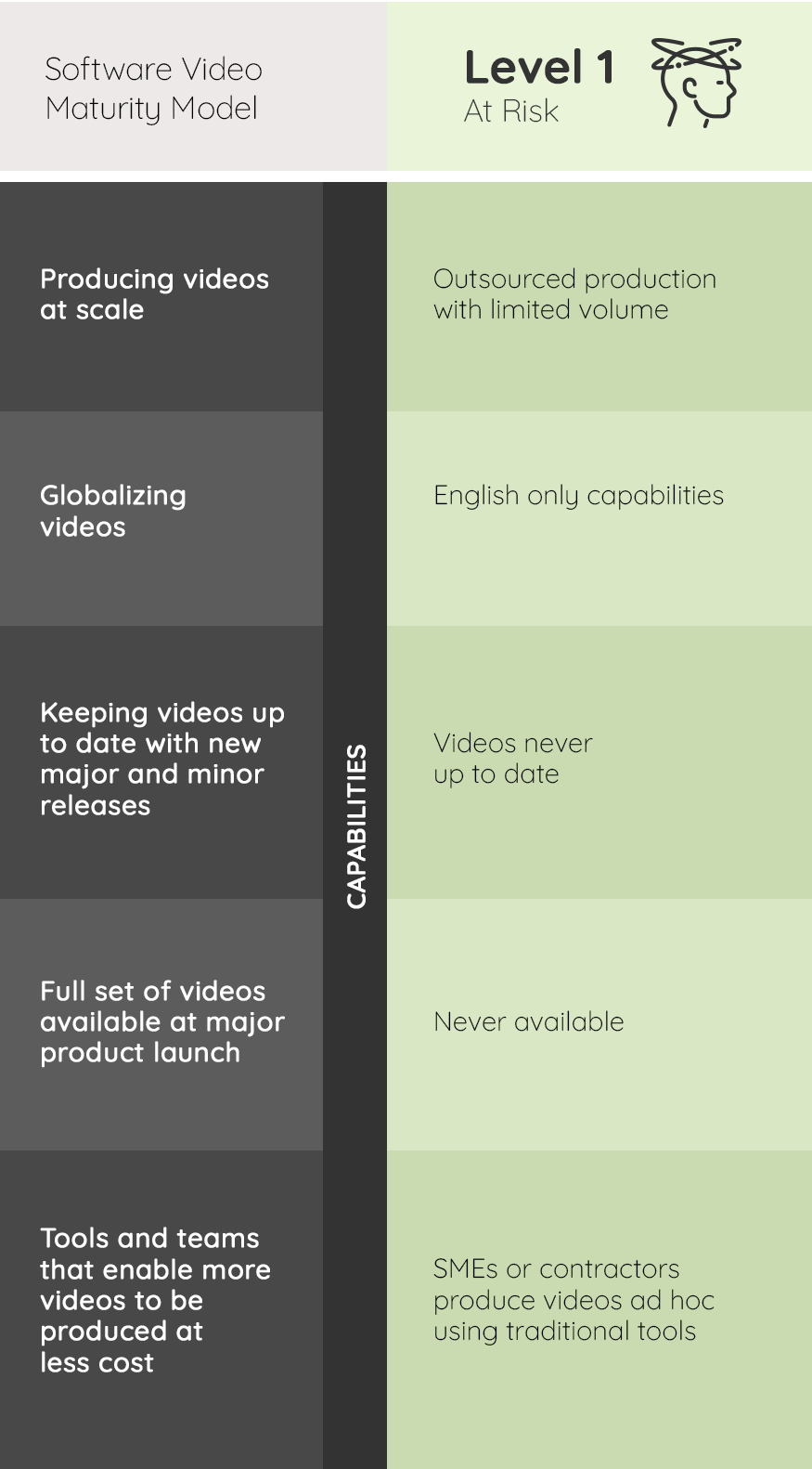
Level 1: At Risk
This is a tough stage, and one that’s not exclusive to small companies. It’s the "random request for video phase". There are limited resources available to produce internally, so as video needs pop up the company must outsource to external contractors or assign scarce internal Subject Matter Experts, or anybody else who has a few days to dedicate to screen recording, voiceover, and editing.
Keep in mind that making these videos is probably not in these workers' job descriptions, and they may not have the skillsets or even the drive to make them - especially when there are so many videos to make.
So, a simple, 3-minute video can take days to complete, and even with all this effort, will probably not look or sound professional.
In fact, 43% of respondents to Videate's latest State of Saas Video Report say it takes two or more days to create one 3-minute video.
This results in a very limited quantity of videos and it’s not at all efficient or cost effective to scale under these circumstances.
Scalability is critical for SaaS companies, and the lack of it is a common pain point when it comes to video. Covering the depth and breadth of your product requires a ton of how-to video content. Add in consistent updates, and the demand for fresh videos quickly gets out of control.
If your company struggles to keep up with video production, you’re not alone. The vast majority of SaaS companies have less than 30% of their product covered.
Given the limitations of the At Risk stage, it’s simply not possible to produce a full set of videos for a product, much less making it available at launch. Such a concept probably feels like a pipe dream if you’re stuck here.
To get out of this stage, companies need to dedicate some resources to solve the video problem.
Level 2: Lagging
Climbing out of At Risk into the Lagging stage requires dedicating at least one video specialist to handle production. Some SaaS companies spread the workload across an internal team, but capacity is still limited, which means scaling production is still a struggle.
The beauty of being a SaaS company is that it’s easy to reach customers on a global scale. The pain of being global is that adding multiple languages exponentially increases the workload.
Only 8% of SaaS companies surveyed offer how-to videos in other languages for their native language UI.
Most are just making do with English-only videos. Not a great experience for global customers.
On the positive side, companies in the Lagging stage can now begin to handle globalizing videos…to a limited extent. Due to the lack of bandwidth, globalized videos are limited to special requests. This means strategizing exactly which videos should be prioritized for translation and native language voiceover.
Due to constant software releases and updates, one of the biggest challenges that SaaS companies face is outdated videos. In fact, 73% of them said that keeping videos up to date with their software was the most challenging aspect of video.
Continuous Delivery of new features is great for customer experience and tough for video production. In 2022, 1 in 4 companies surveyed had releases every 2 weeks. 44% have unpredictable new releases. It starts to feel like as soon as they’ve put out one video, it’s out of date. They’re constantly behind.
In the Lagging stage, it’s possible to update some videos, but not all. So the team needs to determine which ones are mission critical for their customers, like which features are most commonly used or what technical questions create the most support tickets.
Another bit of good news: Lagging companies can provide a full set of videos for their major product releases. The bad news? It’s going to take anywhere from 6 to 12 months to do it.
Many of our customers have come to us from this stage. In fact, if you use Videate, you can skip over the next stage and get right into Best Practice.
Without Videate, to get out of Lagging you’ll need to dedicate a full video team to handle the workload.
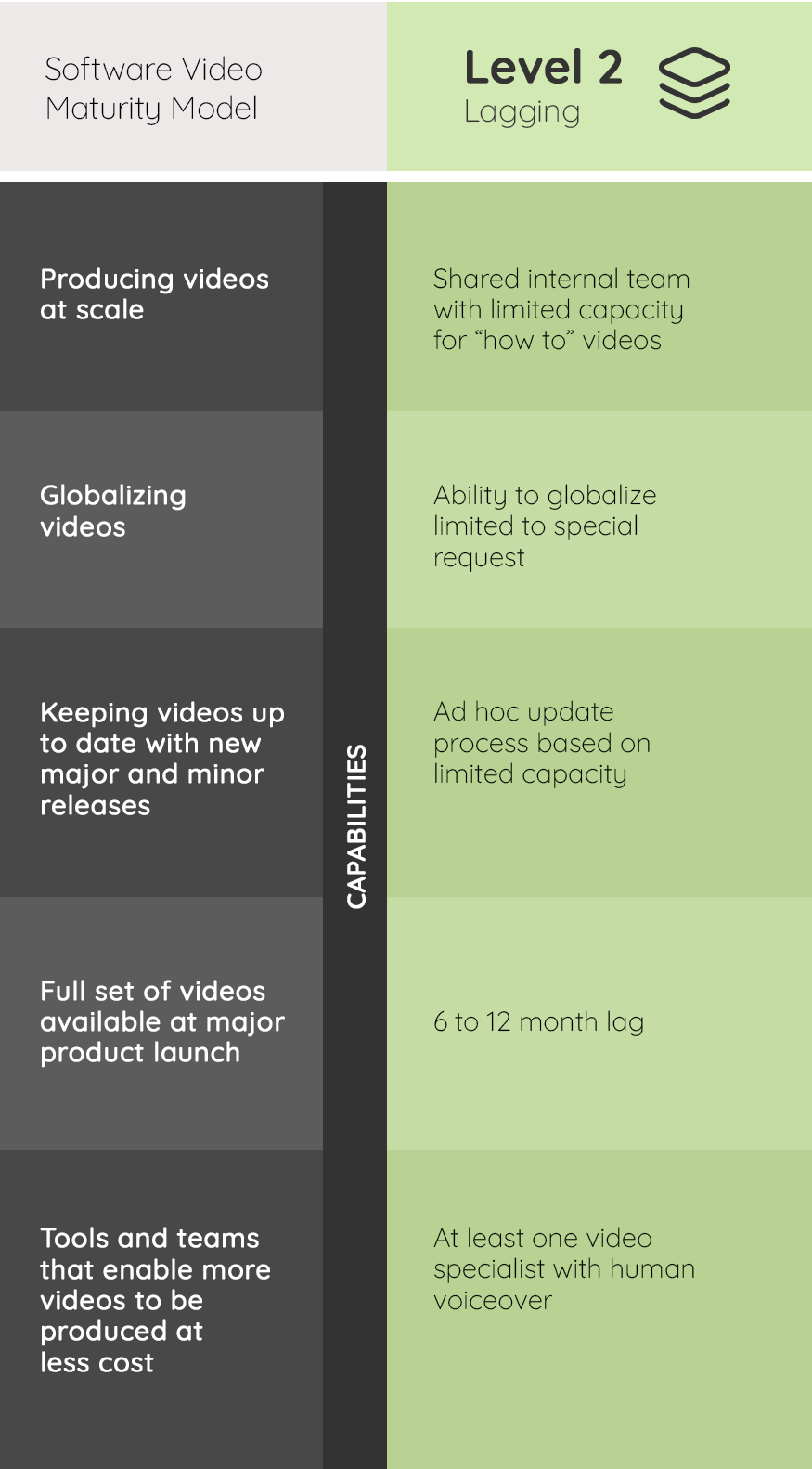
Lagging stage companies take 6-12 months to provide a full set of videos for their major releases.
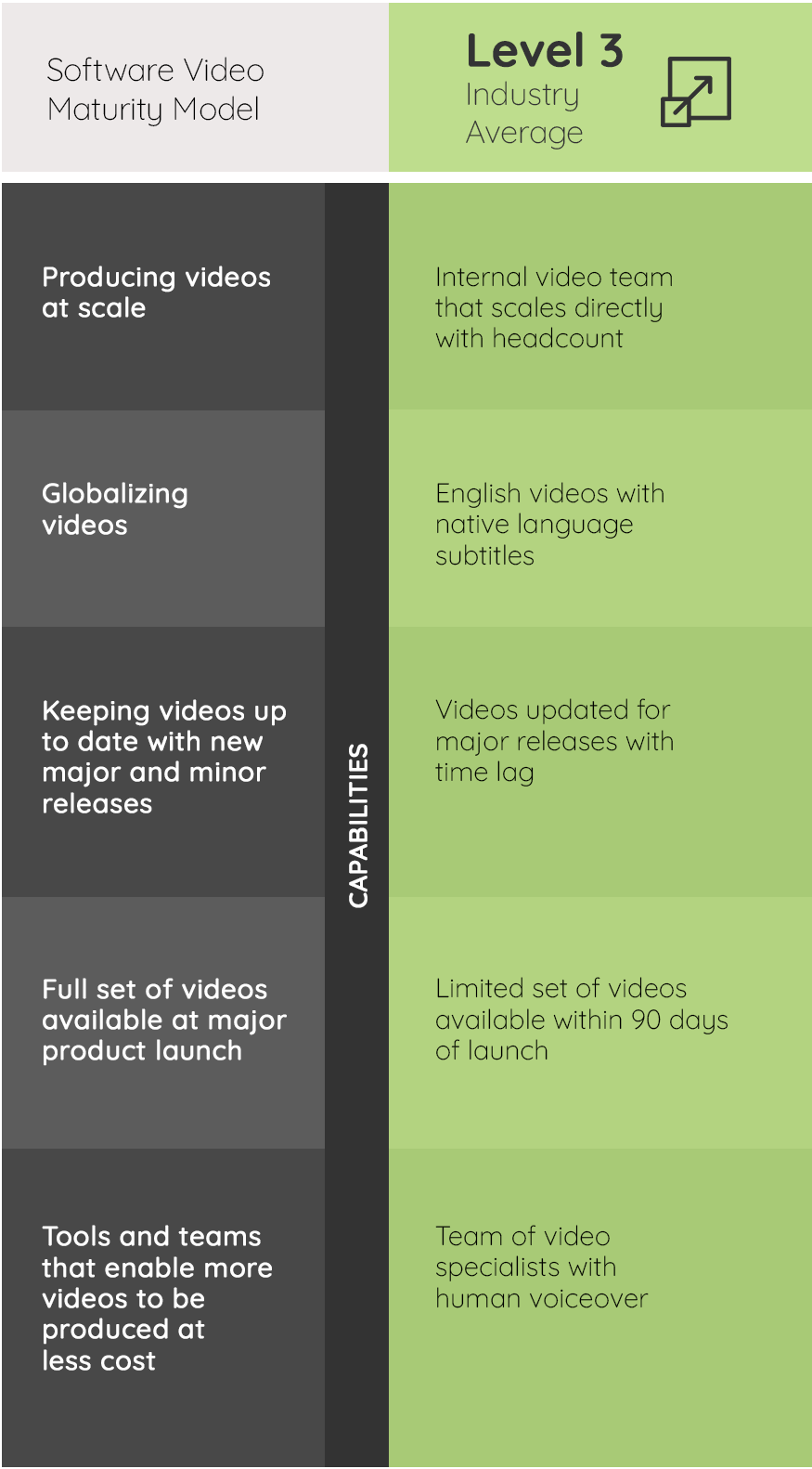
Level 3: Industry Average
To reach the Industry Average stage, a SaaS company needs resources dedicated solely to the video production pipeline. This means a full team of video specialists screen recording, doing voiceover, and editing.
With a full, dedicated team, reaching a scalable video production workflow is possible but does require adding more headcount. Adding products? Languages? Add more headcount.
And so on and so forth, because even best-in-class video teams still need 8-12 hours to make a single 3-minute video.
Great news, though. With a team focused completely on video production, companies are able to keep their videos updated for major releases, just with a time lag. Still, this is leagues better than the previous two stages.
Now we’re getting into a more organized, predictable production environment. Teams can plan for upcoming product updates and even get a limited set of videos out within 90 days of a major launch. This is much better for the customer experience than having nothing at all, which is what the At Risk and Lagging stages provide.
Another pro that comes with a con: Industry Average stage means teams can consistently produce videos for other languages– but even the best-in-class video teams still struggle with scaling that globalization.
Creating multiple language versions of a video still means manually producing new videos:
- Finding a translator who can convert it into another language.
- A voice actor who can speak the language. Editing in the new voice track.
- Re-rendering.
- Re-uploading.
Rinse and repeat for each and every language.
Even the most affluent companies couldn't afford the amount of work that would go into this endeavor. It's simply too much for workers to do - no matter how much money and manpower you throw at it.
Companies in the Industry Average stage work around this globalization problem by producing videos in English and translating only the subtitles. It’s not ideal, but it’s doable, and it’s necessary. 40% of customers will not buy from a site that's in another language, and 75% want product information in their native language. So if all you can do is subtitles, do it, or risk your global customers churning.
Which is why, in order to evolve into the next stage of video maturity, you'll need to use automation.
Level 4: Best Practice
The only way to become scalable with your video content is to automate the grunt work. The "boring stuff".
In this stage, automation and Al generate videos. Text-to-speech generators (which continue to get better every year) create voiceovers. Closed captioning? Automatically generated with every update.
In this stage, 50% or more of your product is covered by video, and 3-minute videos only take 1-3 hours to make.
Furthermore, this process allows you to make 70+ different language versions, each in a matter of minutes.
This speeds up the process in general, but the real magic happens when it comes time to update.
In previous stages video creators had to start over from scratch every time their software changed, leading to a massive (and constantly growing) backlog of videos needing to be updated for accuracy.
Until now, there’s been no way to update dozens or hundreds of videos in time for a product release, major or minor. With automation, you can have a full set of videos available at every major product launch.
Users in the Best Practice stage simply need to tweak their original script (sometimes it's as simple as replacing a word) and run it through the platform.
The time-wasting, repetitive work of manually screen recording and editing is now a distant memory.
Not only is video finally scalable without adding headcount, but your global customers benefit, too. Feed the platform a translated script and it automatically generates a fully-narrated video in the new language.
Since the platform connects to your actual software to generate the videos, you can tell it to generate the video in the specific native language user interface as well. Now customers can see and hear the how-to video in their own language. However, due to the time it still takes to manually translate the scripts, there is still a lag between the English version and the native language version.
This stage solves a lot of problems and finally enables SaaS companies to scale their video libraries. But there is still room to grow…
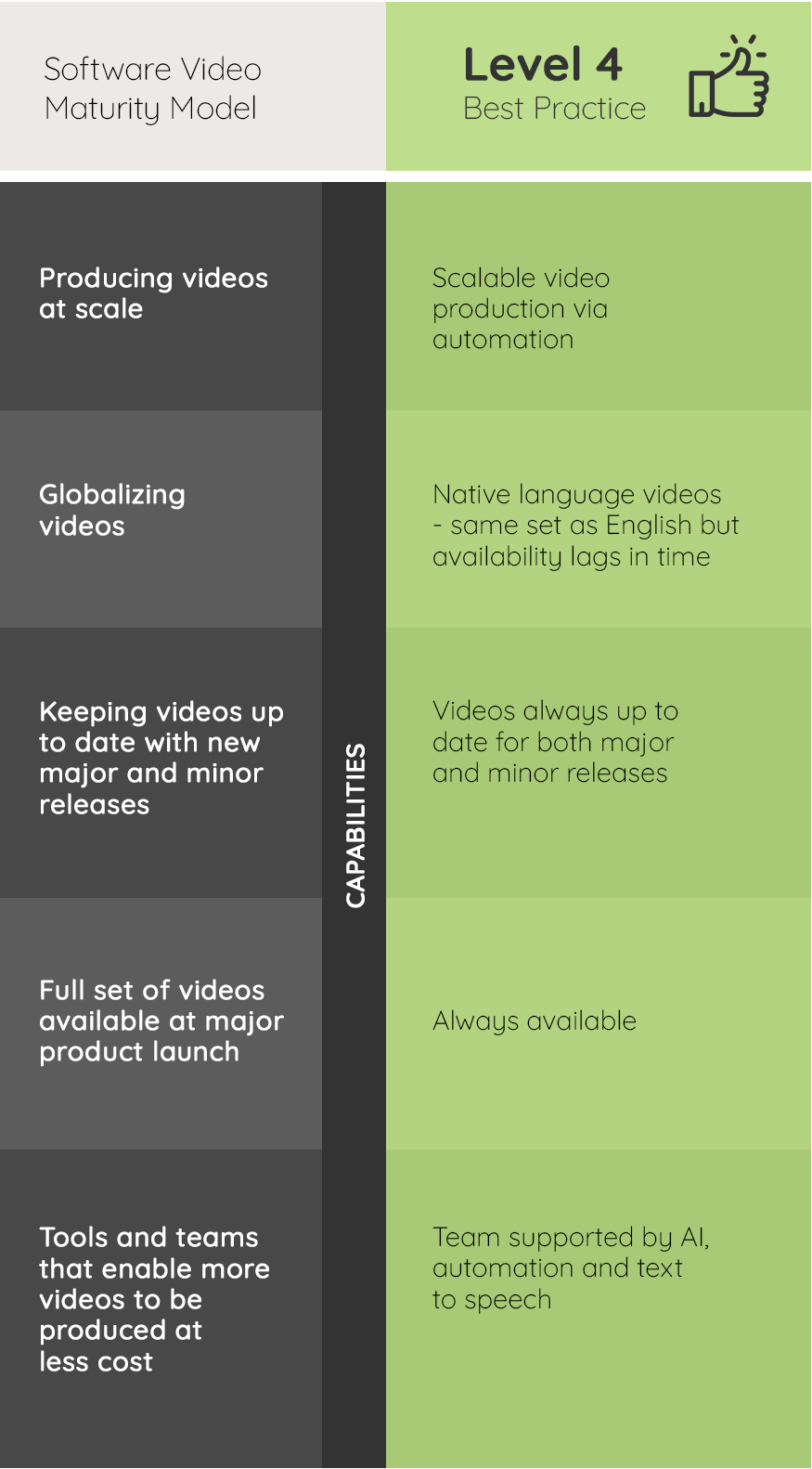
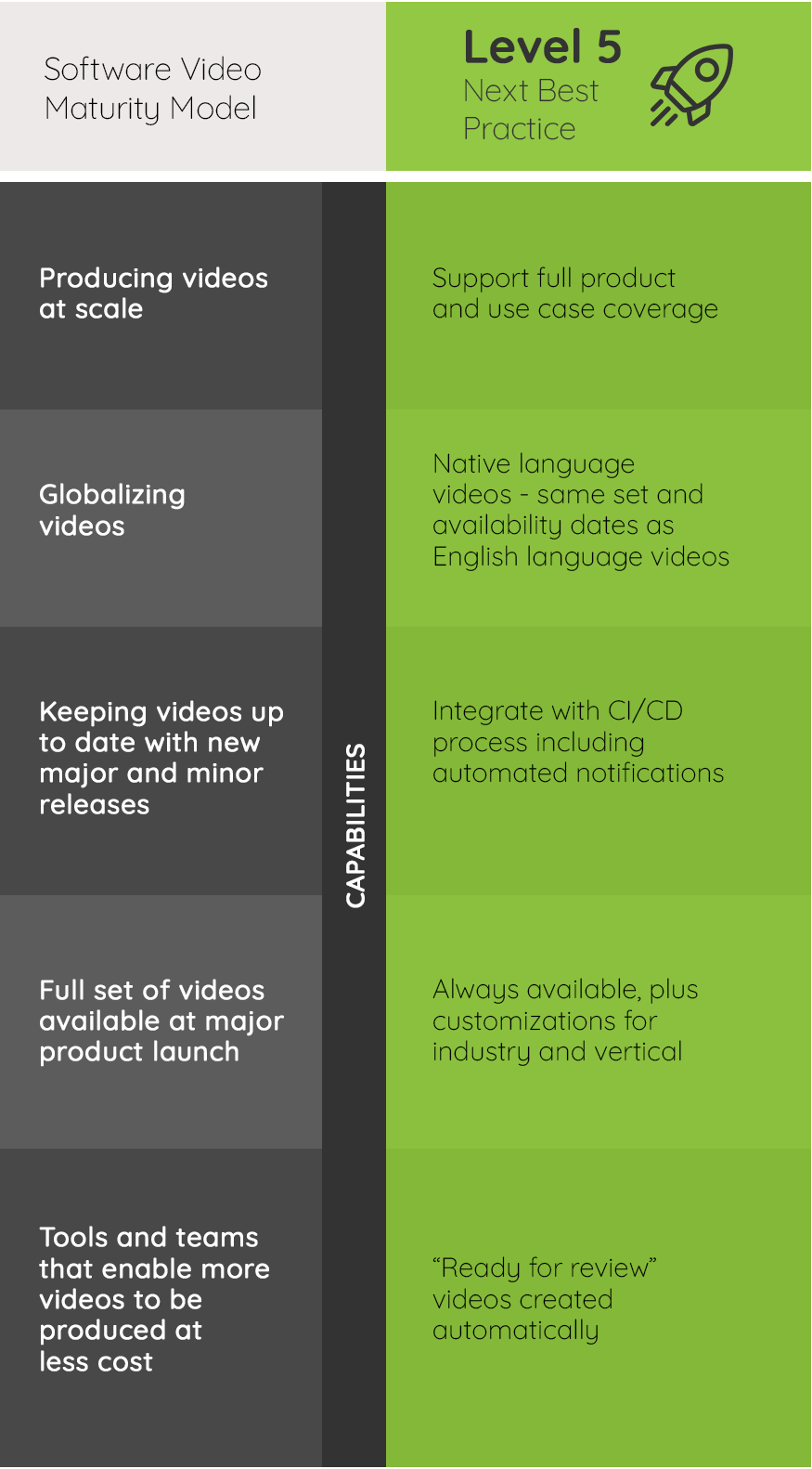
Level 5: Next Best Practice
Videate imagines a future that goes beyond the best practices of today, where all your software products are fully covered across all desired languages.
There’s no lag between translated versions, because we foresee automated translation continuing to get better and better, to the point where you can get a fully, correctly translated script generated instantaneously.
Auto-translation is available even now and can be used in the Best Practice stage, but it's highly recommended you have a native reader check it before making your video. But, one day, maybe even one day soon, you might not have to.
This phase is also heavily reliant on automation, only now, video production is integrated with the Continuous Delivery (CD) process. As soon as your software updates, Videate would automatically update the relevant videos and notify you that new videos are ready for review. No more trying to figure out what changed and then combing through your scripts to make sure they get updated. It’s done for you, automatically.
In the Best Practice stage, a full set of videos are always available immediately upon a release. The Next Best Practice stage improves upon that, because now you can include customizations for industry and vertical. Imagine having specific iterations of the same how-to concept– say, a dashboard– and being able to provide Vertical A a specialized version and Vertical B with another, rather than only displaying the most generic one possible that fits most use cases.
The idea of having a product, update, or function with no matching video will be a thing of the past.
In this future Next Best Practice, is there still room for that human touch? Absolutely. Basically, this takes the boring, manual, frustrating elements of a video team's job and leaves them to focus on more strategic, cutting edge, creative work that is both personally gratifying and grows your company's brand.
There is also the question of discoverability. Daniel Quick, Chief Customer Learning Officer at Scaled Agile, Inc., explains:
“... [A] lot of teams think predominantly about developing content, which obviously is very important. But they don't really have a consumption strategy. They don't really take the next step to figure out how they're going to get this content into the hands of their learners. So, as a result, a very small percentage of people are actually engaging with the content.”
In the future, Al can help with this as well. Quick continues:
"Al can more intelligently recommend and surface content relevant for you. Al can (also) more intelligently determine what are the kinds of experiences you ought to learn, based on how you're engaging with technology."
In essence, a company whose video content has been optimized can provide learners with the exact videos needed, when they need it, without the customers having to go on a major quest to find it.
Who needs to see the Software Video Maturity Model?
The Software Video Maturity Model is a tool that helps companies self-categorize where they are in the scalability of their video production endeavors. C-level executives think in these terms for many other aspects of a company's growth, but very little thought is given to where they are in video content, where they need to be, and what tools they need to get there.
For those of you reading this and seeing the need to automate your videos, Dave Derington, Director of Customer Education at ServiceRocket, recommends getting an internal champion on board:
"If someone is ... focusing on the bigger, broader implications ... and they have the political capability to get leadership to understand the compelling argument to make great content, and how that relates to your business, that's what we need.
The best leaders are the ones that realize that education is everywhere. Learning is everywhere. Marketing is everywhere. And if we are not constantly getting content out in a really compelling, consumable format about what our product can do, we can't unlock scale."
Videate is the path to scalability
The Software Video Maturity Model tells you where you are and where you need to be in terms of Saas video production.
But what comes next? Getting the tools to move from one phase to another.
This is where Videate can help. Videate automates software how-to video production. Even for companies At Risk, Videate can get you into Best Practice without even bothering with Lagging or Industry Average.
Currently, Videate is the only video automation platform on the market that can do this. Users make how-to videos by writing a script that tells the program when and where to move the mouse cursor, click, add highlights, or zoom in, and then Videate does the rest. No editing skills or voiceover required.
Videate will help you:
- Create a complete library of software how-to videos
- Keep videos up-to-date as features change in new releases
- Produce and maintain videos in multiple languages
- Automatically provide closed captions for all videos
Videate was built specifically to help you become scalable. And we do it better than anybody.

